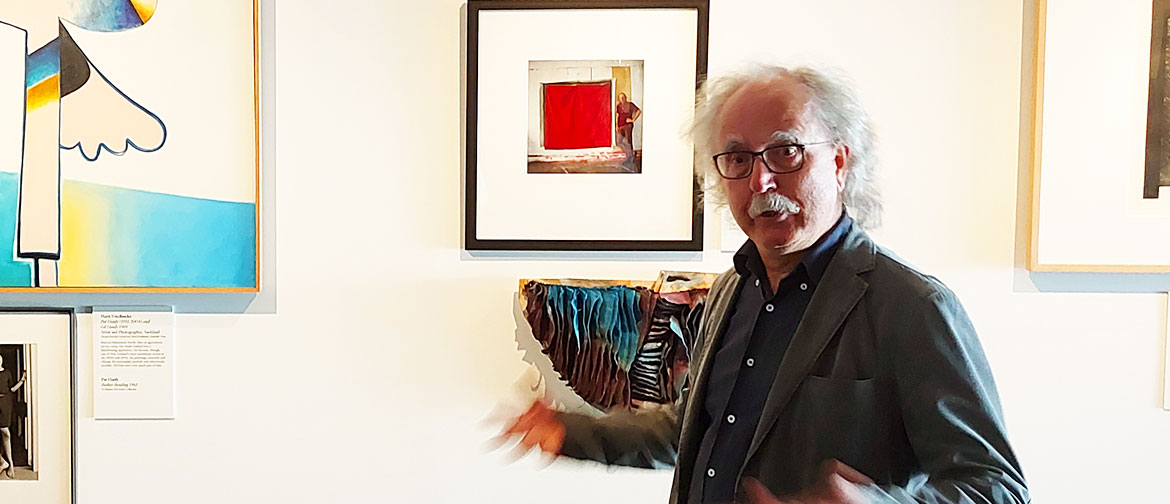With quite a number of Marti’s portraits of artists there is a quality of ambiguity or of ambivalence, both of the artist or writer themselves, and the nature of the relationship between Marti and the person she was photographing. Because they’re not neutral, as most studio commercial photography is. Marti was very much interactive and engaged. She was very quick on her feet, literally and metaphorically, so she didn’t necessarily take a lot of photographs of a person at one time, but she would move around, give directions, sometimes to the point of people feeling intimidated. A number of people have said to me that they felt very intimidated when she was taking photographs of them, and on occasion this can show a bit. Directing in terms of faces and bodies, in terms of light. She almost invariably photographed in natural light. Her photographs result from a kind of calculation, quick thinking and intuition: sensing a person, getting them into a position, taking an angle, to bring out those qualities which she felt or saw in them.
This one here, for instance: Don Driver. A brilliantly absurdist and compelling photo; what on earth is going on? Don Driver lived in New Plymouth. Most artists are drawn to the big cities. Auckland, and to a lesser extent Christchurch and Wellington, tended to have the bulk of artistic activity, particularly artists who were attuned or wanted to be contemporary and modern in their approaches to art. Don Driver was an exception to that, living in New Plymouth. He worked for a while at the Govett-Brewster and had a studio in the basement, where [this photo] might have been taken. Now I’m not sure whether this arrangement of a schoolkid’s chair and the boots and the spray of foliage was an impromptu construction for the occasion of the photograph; I suspect it was. Again, we have this bringing together of what you might think incompatible objects to create this new reality, whatever it might be. Don Driver was a modest, self-effacing and quiet sort of fellow. He’d had a major stroke in about 1976 yet lived on for another 35 years; it did affect him but didn’t seem to affect his art production.
Here we have Ralph Hotere; he and Marti became very close friends when they first met in 1977. He was in Dunedin at that stage. There are many photographs of him in various situations: outside, inside, close-up, distance – they run the whole gamut. When you look at these photographs, they’re like narratives of relationships. It’s quite extraordinary how that can occur when a good photographer works with a person in this interactive way, over a long period. I don’t even think it was necessarily deliberate.
Now these are all Marti’s prints here. Later in her life when she no longer had a dark room, she did have a person, Jill Tomlin, who’s a very good photographer, printing some of her works for her. And in fact – I only found this after her death – this image [of Hotere] has several prints about this size. Now for me, this is the one that works best. In relation to the big ones of course it looks immediately compressed. An attic space is by its very nature a private space. Ralph Hotere was a very private person, he didn’t like talking about his art, yet here he is, alone with a person he was very friendly with – though they didn’t necessarily see one another a lot.
Rita Angus, of course. In this instance, all the photographs Marti took, and there were a lot of them, were taken on a single day in Wellington in 1969. Friedlander had a painting by Rita Angus. She happened to be in Wellington and just on the off-chance Marti thought she should knock on the door of Rita Angus, who again was a notoriously private person; she could take it very badly if people turned up at her door. She was a fiery and at times quite mentally disturbed person: reading her letters in the Turnbull Library, the things she could write about people! So Marti knocked on the door and Rita said, “come back tomorrow”. The next day was devoted to taking photos of Rita Angus: an extraordinary variety of photos. Outside and inside the house. Ones like this where there’s a play on duality; the sense from the portrait is of [the painted] Rita Angus looking at us, engaging with us, whereas the actual person is glancing to the side, as if a bit wary of face-to-face contact. Again, they got on very well and Rita Angus liked the photographs. They’ve been widely published since the early ‘70s.
The other thing I think is worth noting is that Marti was a highly skilled technician printing from negatives. And the negative wasn’t for her the finished photograph. There’s one school of photography that would assert the integrity of the negative, that you must print the photograph as it appears in the negative. Of course, the best photographers have never done that. Marti’s croppings could be quite extraordinary; there are some where the print is about a third of the negative. So you can find different croppings – effectively different images – of the same person from the one negative. It’s like looking at the person from different angles and perspectives.
She would have been the first person to say you can never “capture” a person in one photograph. You can visualise qualities as you’ve experienced them but there’s no way you’re going to capture a person, define a person in a photograph, or even 500 photographs. But that was very much a quality of her photographs of artists and writers, trying to visualise aspects of a person as she experienced them, which hopefully would also say something about the artist and their works.
Michael Illingworth lived in Auckland during the ‘60s, and in the early ‘70s moved to rural areas. I don’t think “hippie” is the right word, but he was very much part of that current of “back to nature”, communes and so on. In fact, to the best of my knowledge, his wife Dene still lives on the property up on the Coromandel. She liked taking photographs of couples, because all couples are complex. There are going to be a whole range of ambivalences. But extraordinary photographs of Michael and Dene Illingworth are more than just pictures of them. They’re pictures of a social environment, which was very specific to its time. And what’s always struck me about this [gourd in the photo]…it’s perfect! On the one hand, why – for this has been placed very calculatingly – put a gourd on the table with two people? Yet remove the gourd and that photograph would be diminished.
There was one famous writer on photography, and famous generally as a cultural commentator, Roland Barthes, who wrote very brilliantly on photography. He postulated this notion of the “punctum” – in other words an element in a photograph – and he’s talking about the great photographs that really hold you and engage you. The punctum is a detail in a photograph that pricks or punctures, that brings you in. Like this anomalous detail, which in one sense is inexplicable, but in another it’s crucial to the image.
Marti’s training as a painter, her knowledge of art, comes through strongly in all these photographs. Her compositions are arrived at in the course of printing and cropping. When she was doing commissioned work for papers or periodicals – should I reveal this? I don’t think she’d really mind, she was pretty outrageous on occasion – she might sometimes touch things up with a ballpoint pen. “This is good enough!” I don’t know if that gives a sense of the sort of person she was. Mercurial, a great friend, at the same time she could be infuriating. She talked to everyone. In the last 20 years of her life she spent most mornings in the cafes in Parnell, and whoever turned up she’d be engaging in conversation.
So these come out of close, enthusiastic, sometimes abrasive interactions with a whole variety of people. Some she had prolonged relationships with, others she didn’t. There were one or two photographs where they’re brilliant photographs, but you somehow sense that they didn’t really like one another. There are some photographs of Louise Henderson the artist, who was a pretty assertive character – you wouldn’t cross Louise – and I never asked but I sensed from one group of photographs that Louise was pretty reluctant. There was a sort of mutual suspicion, almost bouncing off the image. And as I said, a couple of people I know, they found the experience of being photographed quite intimidating. Yet the photographs are just fantastic. So she’s a bit like one of these brilliant film directors who could make it difficult for their actors.




